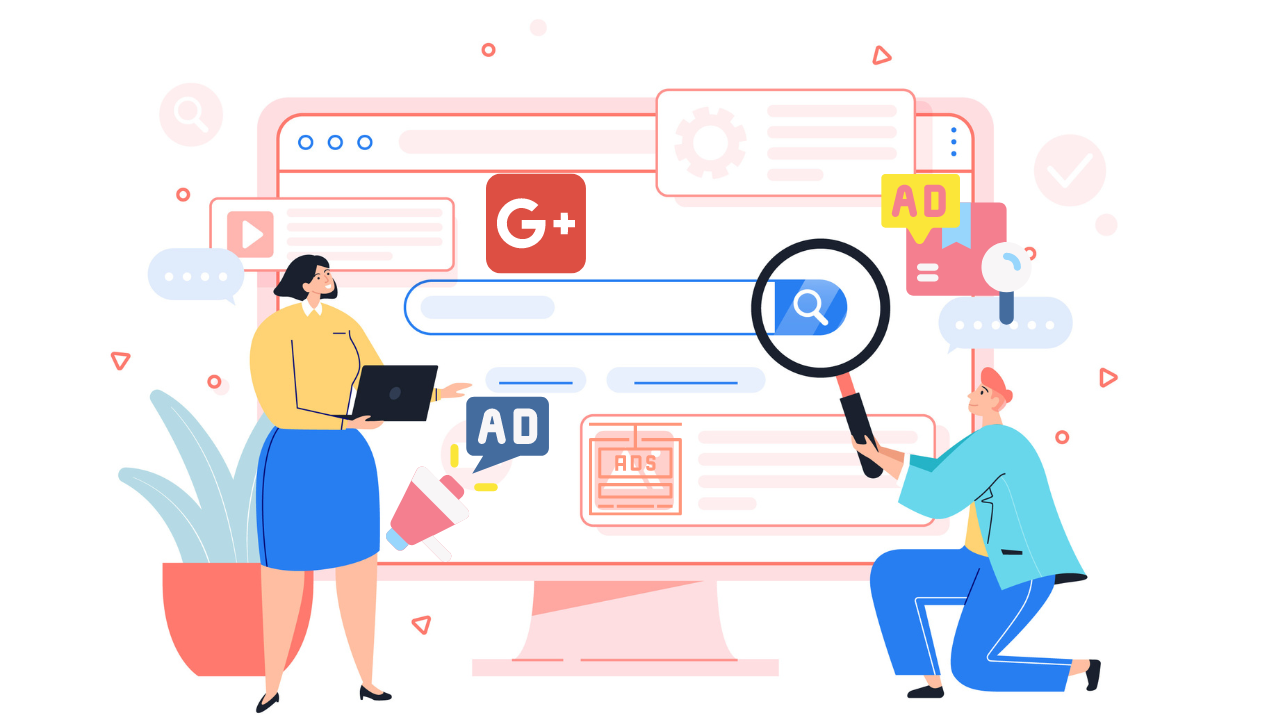Google AdWords (now known as Google Ads) is a powerful platform for driving targeted traffic to your website and converting visitors into clients. With millions of searches performed daily, harnessing the potential of Google Ads can significantly impact your business's growth. However, to turn clicks into clients effectively, you need a well-planned strategy and a keen understanding of the platform's features and best practices. This detailed guide explores effective strategies for Google Ads success, providing insights on campaign setup, optimization, and performance measurement.
Understanding Google Ads
Google Ads is an online advertising platform that allows businesses to display ads on Google's search results pages, YouTube, and other websites within the Google Display Network. Advertisers bid on keywords relevant to their target audience, and ads are displayed based on these bids and the quality of the ad content.
Key Components of Google Ads
- Campaigns: Organized groups of ad sets, keywords, and ads targeting specific goals or audiences.
- Ad Groups: Collections of ads and keywords within a campaign, focusing on related themes or products.
- Keywords: Terms or phrases that trigger your ads when users search for them.
- Ads: The actual content displayed to users, including text ads, display ads, and video ads.
- Bidding: The amount you're willing to pay per click or impression on your ads.
- Quality Score: A metric that evaluates the relevance and quality of your keywords, ads, and landing pages.
Effective Strategies for Google Ads Success
1. Define Clear Objectives
Establishing clear objectives is crucial for creating a successful Google Ads campaign. Your objectives will guide your strategy, targeting, and ad creation.
Common Objectives:
- Increase Website Traffic: Drive more visitors to your website.
- Generate Leads: Capture contact information from potential clients.
- Boost Sales: Increase online or offline sales of your products or services.
- Enhance Brand Awareness: Improve visibility and recognition of your brand.
Example Objective: If you're running an aesthetic clinic, you might aim to increase appointment bookings through your website by 25% in the next three months.
2. Conduct Thorough Keyword Research
Keyword research is the foundation of a successful Google Ads campaign. Identify relevant keywords that potential clients use to search for services related to your business.
Steps for Keyword Research:
- Brainstorm Keywords: List terms and phrases related to your business, products, and services.
- Use Keyword Tools: Utilize tools like Google Keyword Planner, SEMrush, or Ahrefs to find keyword suggestions and search volumes.
- Analyze Competitors: Examine keywords that your competitors are targeting to identify opportunities and gaps.
- Consider Long-Tail Keywords: Focus on specific, less competitive phrases that attract highly targeted traffic.
Example: For an aesthetic clinic, keywords might include “Botox treatments near me,” “skincare services,” or “facial rejuvenation.”
3. Craft Compelling Ad Copy
Your ad copy is the first impression potential clients have of your business. Craft compelling and relevant ads to encourage users to click through to your website.
Key Elements of Effective Ad Copy:
- Headline: Create attention-grabbing headlines that include your primary keywords.
- Description: Write clear and persuasive descriptions highlighting the benefits of your services.
- Call-to-Action (CTA): Include a strong CTA to prompt users to take the desired action (e.g., “Book Your Appointment Today!”).
- Ad Extensions: Use ad extensions to provide additional information and enhance your ad’s visibility (e.g., location, phone number, site links).
Example Ad Copy:
- Headline 1: “Transform Your Skin with Expert Botox”
- Headline 2: “Book Your Free Consultation Today!”
- Description: “Experience professional Botox treatments at our clinic. Safe, effective, and tailored to your needs. Schedule your consultation now.”
- CTA: “Book Now”
4. Optimize Landing Pages
Your landing pages play a critical role in converting clicks into clients. Ensure that your landing pages are optimized for relevance, user experience, and conversion.
Landing Page Optimization Tips:
- Match Ad Messaging: Ensure the content of your landing page aligns with your ad copy and keywords.
- Clear CTA: Place a prominent and compelling CTA on your landing page.
- Mobile-Friendly Design: Optimize your landing page for mobile devices to cater to users on smartphones and tablets.
- Fast Load Times: Ensure your landing page loads quickly to prevent potential clients from leaving due to slow performance.
- Easy Navigation: Provide a seamless user experience with straightforward navigation and minimal distractions.
Example: If your ad promotes Botox treatments, your landing page should provide detailed information about the procedure, include testimonials, and feature an easy-to-use appointment booking form.
5. Implement Effective Bidding Strategies
Choosing the right bidding strategy can impact the performance and cost-effectiveness of your Google Ads campaigns. Google Ads offers various bidding options to suit different objectives.
Bidding Strategies:
- Manual CPC (Cost-Per-Click): Control the maximum bid you’re willing to pay for each click.
- Enhanced CPC (ECPC): Adjust bids automatically to increase conversions while maintaining cost control.
- Target CPA (Cost-Per-Acquisition): Set a target cost per acquisition, and Google Ads will optimize bids to meet this target.
- Maximize Conversions: Automatically adjust bids to get the most conversions within your budget.
- Target ROAS (Return on Ad Spend): Set a target return on ad spend, and Google Ads will optimize bids to achieve this target.
Example: If your goal is to maximize appointments, you might use Target CPA to focus on achieving a specific cost per booking.
6. Monitor and Adjust Campaign Performance
Regular monitoring and adjustment of your Google Ads campaigns are essential for maintaining optimal performance and ROI.
Key Performance Metrics to Track:
- CTR (Click-Through Rate): Measure the percentage of users who click on your ads compared to the number of impressions.
- Conversion Rate: Track the percentage of clicks that result in desired actions (e.g., appointments, purchases).
- CPA (Cost-Per-Acquisition): Calculate the average cost to acquire a new client or lead.
- ROAS (Return on Ad Spend): Evaluate the revenue generated for every dollar spent on advertising.
- Quality Score: Monitor your ad’s Quality Score to ensure relevance and improve ad positioning.
Optimization Techniques:
- A/B Testing: Test different ad variations, landing pages, and bidding strategies to determine what works best.
- Adjust Keywords: Refine your keyword list based on performance data, adding high-performing keywords and excluding underperformers.
- Analyze Search Queries: Review search queries to identify new keywords and negative keywords to prevent irrelevant traffic.
7. Utilize Remarketing Campaigns
Remarketing allows you to target users who have previously interacted with your website or ads but did not convert. This strategy helps re-engage potential clients and increase conversion rates.
Remarketing Techniques:
- Standard Remarketing: Show ads to users who have visited your website or specific pages.
- Dynamic Remarketing: Display personalized ads based on users’ previous interactions with your website (e.g., specific products or services viewed).
- Remarketing Lists for Search Ads: Target users who have previously visited your website and are conducting related searches on Google.
Example: If a user visited your landing page for Botox treatments but did not book an appointment, you can use remarketing ads to remind them of your services and encourage them to return and complete the booking.
8. Leverage Ad Scheduling and Geo-Targeting
Ad scheduling and geo-targeting help optimize your ads’ performance by focusing on the most relevant times and locations for your target audience.
Ad Scheduling: Set specific times and days when your ads should be displayed based on when your target audience is most active and likely to convert.
Geo-Targeting: Target specific geographic locations to reach users in your area or areas where your services are available. Adjust bids for different locations based on performance and relevance.
Example: If your aesthetic clinic operates only in a particular city, use geo-targeting to ensure your ads are shown only to users in that city, and use ad scheduling to display ads during your clinic's business hours.
Achieving success with Google Ads involves a strategic approach that encompasses setting clear objectives, conducting thorough keyword research, crafting compelling ad copy, optimizing landing pages, implementing effective bidding strategies, and continuously monitoring and adjusting your campaigns. Leveraging remarketing, ad scheduling, and geo-targeting further enhances your ability to convert clicks into clients and maximize your return on investment.
By following these strategies and best practices, you can create high-performing Google Ads campaigns that drive targeted traffic to your website, engage potential clients, and ultimately grow your business. Remember, Google Ads is a dynamic platform, and staying informed about updates and trends will help you maintain a competitive edge and achieve sustained success.


